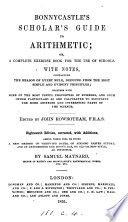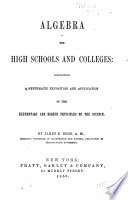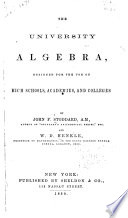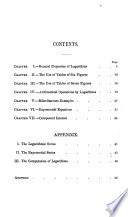 | Thomas Keith - Arithmetic - 1822 - 354 pages
...their difference, will give the less number. 7. The quotient, arising from tlie division of tbe sum of two, or more, numbers, is equal to the sum of the quotients arising from tha division of the parts, separately, by the iame divisor. „ 8. If any two... | |
 | John H. Harney - Algebra - 1840 - 298 pages
...immediately seen. This can often be done by re-solving the number into two or more factors, for the root of the product of two or more numbers is equal to the product of the roots of those numbers. It is required to find the second root of 196. 4 X 49 = 196.... | |
 | William Vogdes - Arithmetic - 1847 - 324 pages
...half their difference, will give the less number. The quotient, arising from the division of the sum of two, or more numbers, is equal to the sum of the quotients arising from the division of each number separately, by the same divisor. If any two numbers... | |
 | Olinthus Gilbert Gregory - 1848 - 572 pages
...for multiplying powers, (page 50,) r1 x r'' = r1 * '> = N x N, ; and NN, . Ns =r' + 'i + '». Or tfte logarithm of the product of two or more numbers, is equal to the sum of the logaritltms of those numbers; and conversely, the logarithm of the quotient of ttco numbers, is equal... | |
 | William Vogdes - 1849 - 134 pages
...half their difference, will give the less number. The quotient, arising from the division of the sum of two, or more numbers, is equal to the sum of the quotients arising from the division of each number separately, by the same divisor. If any two numbers... | |
 | John Bonnycastle - 1851 - 314 pages
...their difference, will give the less number. 2. The quotient, arising from the division of the sum of two or more numbers, is equal to the sum of the quotients arising from the division of the parts, separately, by the same divisor. the question ; then,... | |
 | William Templeton (engineer.) - 1852 - 284 pages
...half their difference, will give the less number. 2. The quotient arising from the division of the sum of two or more numbers, is equal to the sum of the quotients arising from the division of the parts separately, by the same divisor. 3. Any three of the... | |
 | James B. Dodd - Algebra - 1859 - 368 pages
...0 is the logarithm of 1, and in the second, 1 is the logarithm of a. Logarithm of a Product. (308.) The Logarithm of the product of two or more numbers,...equal to the sum of the logarithms of those numbers. In the equations ax=n and av=m, the exponents, x and y, are the logarithms of' n and m, for the base... | |
 | John Fair Stoddard, William Downs Henkle - Algebra - 1859 - 538 pages
...and when a<l, we have «"=0. PROPOSITION 4. (481.) In every system, the logarithm of the continued product of two or more numbers is equal to the sum of the logarithm of tht numbers, since when a'—u and a'=z, we have a'+"=«2. P RO POSITION 5. (482.) In... | |
 | William Henry Johnstone - 1859 - 80 pages
...value of a. Hence loga a = l, and Iog0l = 0. 5. ln any system, the logarithm of the product of any numbers is equal to the sum of the logarithms of those numbers. Let ax=m, a° = n, a'=p,&c. or x = logam, у = log, n, z = logap, &c. then mxn xp x &c. — a" x as... | |
| |